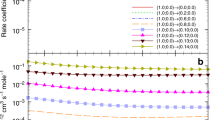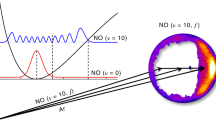Abstract
MANY observations of gaseous bimolecular exchange reactions in which vibrationally excited products appear have been interpreted1–3 in terms of a simple model developed by F. T. Smith2. Smith's treatment, based on the kinematics of a collinear collision, predicts that the upper limit to the fraction of energy of reaction which may appear as product vibration is sin2 β, where β is the angle between the skewed axes of the potential energy surface on which a sliding mass point represents the progress of the collision. Observed vibrational energies in excess of the amount calculated in this way have usually been interpreted as contravening Smith's model. It is the purpose of the present communication to point out that when the Smith treatment is generalized by lifting the restriction that collisions be collinear, it becomes apparent that the fraction being calculated is more nearly a lower limit than an upper. As a result certain changes in the interpretation of the experimental evidence are required.
This is a preview of subscription content, access via your institution
Access options
Subscribe to this journal
Receive 51 print issues and online access
$199.00 per year
only $3.90 per issue
Buy this article
- Purchase on Springer Link
- Instant access to full article PDF
Prices may be subject to local taxes which are calculated during checkout
Similar content being viewed by others
References
Basco, N., and Norrish, R. G. W., Nature, 189, 455 (1961); Proc. Roy. Soc., A, 260, 293 (1961); Canad. J. Chem., 38, 1769 (1960).
Smith, F. T., J. Chem. Phys., 31, 1352 (1959).
Jones, W. M., and Davidson, N., J. Amer. Chem. Soc. (in the press).
Cross, P. C., and Van Vleck, J. H., J. Chem. Phys., 1, 350 (1933); Eq. 6.
Glasstone, S., Laidler, K. J., and Eyring, H., The Theory of Rate Processes, 101 (McGraw-Hill Book Co., Inc., New York, 1941).
Polanyi, J. C., J. Chem. Phys., 31, 1338 (1959).
Author information
Authors and Affiliations
Rights and permissions
About this article
Cite this article
BUNKER, D. Vibrationally Excited Products of Bimolecular Exchange Reactions. Nature 194, 1277–1278 (1962). https://doi.org/10.1038/1941277a0
Issue Date:
DOI: https://doi.org/10.1038/1941277a0
Comments
By submitting a comment you agree to abide by our Terms and Community Guidelines. If you find something abusive or that does not comply with our terms or guidelines please flag it as inappropriate.



